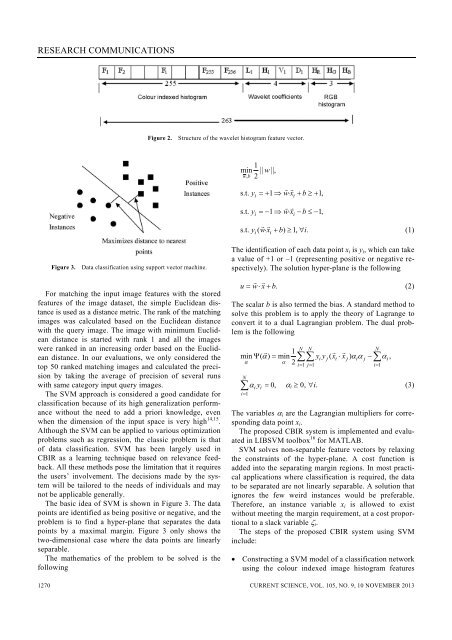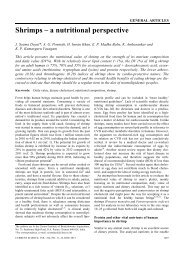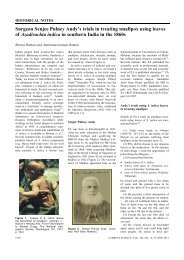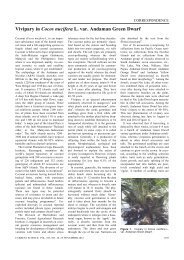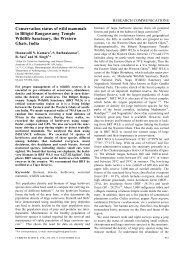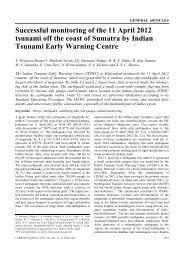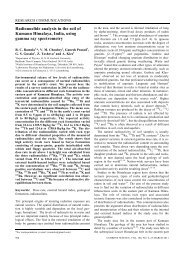Improved content-based classification and retrieval of images using ...
Improved content-based classification and retrieval of images using ...
Improved content-based classification and retrieval of images using ...
You also want an ePaper? Increase the reach of your titles
YUMPU automatically turns print PDFs into web optimized ePapers that Google loves.
RESEARCH COMMUNICATIONS<br />
Figure 2.<br />
Structure <strong>of</strong> the wavelet histogram feature vector.<br />
1<br />
min || w ||,<br />
wb , 2<br />
<br />
s.t. y 1 wx .<br />
<br />
= + ⇒ + b≥ + 1,<br />
i<br />
<br />
s.t. y 1 wx .<br />
<br />
= − ⇒ −b≤−1,<br />
i<br />
<br />
s.t. ( .<br />
<br />
y wx + b) ≥1, ∀i.<br />
i<br />
i<br />
i<br />
i<br />
(1)<br />
1270<br />
Figure 3.<br />
Data <strong>classification</strong> <strong>using</strong> support vector machine.<br />
For matching the input image features with the stored<br />
features <strong>of</strong> the image dataset, the simple Euclidean distance<br />
is used as a distance metric. The rank <strong>of</strong> the matching<br />
<strong>images</strong> was calculated <strong>based</strong> on the Euclidean distance<br />
with the query image. The image with minimum Euclidean<br />
distance is started with rank 1 <strong>and</strong> all the <strong>images</strong><br />
were ranked in an increasing order <strong>based</strong> on the Euclidean<br />
distance. In our evaluations, we only considered the<br />
top 50 ranked matching <strong>images</strong> <strong>and</strong> calculated the precision<br />
by taking the average <strong>of</strong> precision <strong>of</strong> several runs<br />
with same category input query <strong>images</strong>.<br />
The SVM approach is considered a good c<strong>and</strong>idate for<br />
<strong>classification</strong> because <strong>of</strong> its high generalization performance<br />
without the need to add a priori knowledge, even<br />
when the dimension <strong>of</strong> the input space is very high 14,15 .<br />
Although the SVM can be applied to various optimization<br />
problems such as regression, the classic problem is that<br />
<strong>of</strong> data <strong>classification</strong>. SVM has been largely used in<br />
CBIR as a learning technique <strong>based</strong> on relevance feedback.<br />
All these methods pose the limitation that it requires<br />
the users’ involvement. The decisions made by the system<br />
will be tailored to the needs <strong>of</strong> individuals <strong>and</strong> may<br />
not be applicable generally.<br />
The basic idea <strong>of</strong> SVM is shown in Figure 3. The data<br />
points are identified as being positive or negative, <strong>and</strong> the<br />
problem is to find a hyper-plane that separates the data<br />
points by a maximal margin. Figure 3 only shows the<br />
two-dimensional case where the data points are linearly<br />
separable.<br />
The mathematics <strong>of</strong> the problem to be solved is the<br />
following<br />
The identification <strong>of</strong> each data point x i is y i , which can take<br />
a value <strong>of</strong> +1 or –1 (representing positive or negative respectively).<br />
The solution hyper-plane is the following<br />
<br />
u = w⋅ x+<br />
b.<br />
The scalar b is also termed the bias. A st<strong>and</strong>ard method to<br />
solve this problem is to apply the theory <strong>of</strong> Lagrange to<br />
convert it to a dual Lagrangian problem. The dual problem<br />
is the following<br />
N N N<br />
∑∑yy i j xi xj i j ∑ i<br />
i= 1 j= 1 i=<br />
1<br />
1 <br />
min Ψ ( α) = min ( ⋅ ) αα − α ,<br />
α<br />
α 2<br />
N<br />
i=<br />
1<br />
(2)<br />
∑ α iyi<br />
= 0, α i ≥ 0, ∀i. (3)<br />
The variables α i are the Lagrangian multipliers for corresponding<br />
data point x i .<br />
The proposed CBIR system is implemented <strong>and</strong> evaluated<br />
in LIBSVM toolbox 16 for MATLAB.<br />
SVM solves non-separable feature vectors by relaxing<br />
the constraints <strong>of</strong> the hyper-plane. A cost function is<br />
added into the separating margin regions. In most practical<br />
applications where <strong>classification</strong> is required, the data<br />
to be separated are not linearly separable. A solution that<br />
ignores the few weird instances would be preferable.<br />
Therefore, an instance variable x i is allowed to exist<br />
without meeting the margin requirement, at a cost proportional<br />
to a slack variable ζ i .<br />
The steps <strong>of</strong> the proposed CBIR system <strong>using</strong> SVM<br />
include:<br />
• Constructing a SVM model <strong>of</strong> a <strong>classification</strong> network<br />
<strong>using</strong> the colour indexed image histogram features<br />
CURRENT SCIENCE, VOL. 105, NO. 9, 10 NOVEMBER 2013


